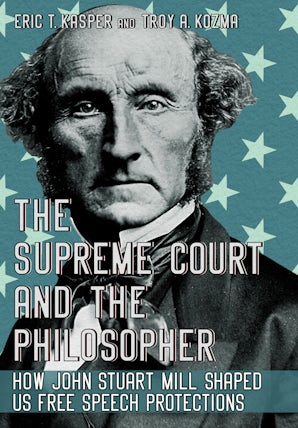 Vol. 35 No. 02 (October 2025) pp. 20-24
Vol. 35 No. 02 (October 2025) pp. 20-24THE SUPREME COURT AND THE PHILOSOPHER: HOW JOHN STUART MILL SHAPED U.S. FREE SPEECH PROTECTIONS, by Eric Kasper and Troy Kozma. Ithaca: Northern Illinois University Press, an imprint of Cornell University Press, 2024. 288pp. Cloth $44.95. ISBN: 97815017745150.
Reviewed by Cary Federman. Department of Justice Studies. Montclair State University. Email: federmanc@montclair.edu.
In 1918, Congress passed the Sedition Act, empowering federal authorities to arrest those who sought to “incite, provoke and encourage resistance to the United States.” In due course, the government convicted five men, including Jacob Abrams, for distributing leaflets supporting a general strike, Russian communism, and Marxist calls for working-class unity. The majority opinion in Abrams v. U.S. (1919) concludes with two points: (1) Congress has the power to pass such legislation, and (2) the jury acted according to the law. Justice Oliver Wendell Holmes’s dissent, however, stands out for more than its florid language. Earlier that year, Holmes authored three unanimous opinions on the same day — Schenck v. U.S. (1919), Frohwerk v. U.S. (1919), and Debs v. U.S. (1919) — each upholding convictions of war critics under the 1917 Espionage Act. What changed?
According to Eric Kasper and Troy Kozma, the former a political scientist and the latter a philosophy professor, Holmes applied a “Millian analysis” (p. 49) absent from the opinions in Abrams, Schenck, Frohwerk, and Debs. Millian analysis is the application of John Stuart Mill’s “harm principle” to speech cases plus Mill’s idea that no one person or group of people can claim certainty over an idea. Holmes wrote: “the best test of truth is the power of the thought to get itself accepted in the competition of the market.” The “marketplace of ideas” metaphor is a modified version of Mill’s epistemological uncertainty principle, which states that because “[w]e can never be sure that the opinion we are endeavoring to stifle is a wrong opinion” (Mill 1978, 16), a “civilized community” (Mill 1978, 9) must tolerate dissenting opinions. Presuming America to be that kind of community, Holmes argued that the First Amendment must allow each individual the right to seek truth. This, Holmes wrote, “is the theory of our Constitution.”
In The Supreme Court and the Philosopher, Kasper and Kozma set out to examine nearly every free speech case the Supreme Court has decided since the end of World War I through a Millian lens. The book has nine chapters, plus an introduction and a conclusion. Chapter Two covers cases decided prior to Holmes’s embrace of Mill’s ideas in On Liberty. This was not a Millian era. Because the Supreme Court did not yet apply
 Vol. 35 No. 02 (October 2025) pp. 17-19
Vol. 35 No. 02 (October 2025) pp. 17-19 Vol. 35 No. 02 (October 2025) pp. 14-16
Vol. 35 No. 02 (October 2025) pp. 14-16 Vol. 35, No. 01 (March 2025) pp. 11-13
Vol. 35, No. 01 (March 2025) pp. 11-13
 Vol. 35 No. 01 (March 2025) pp. 8-10
Vol. 35 No. 01 (March 2025) pp. 8-10